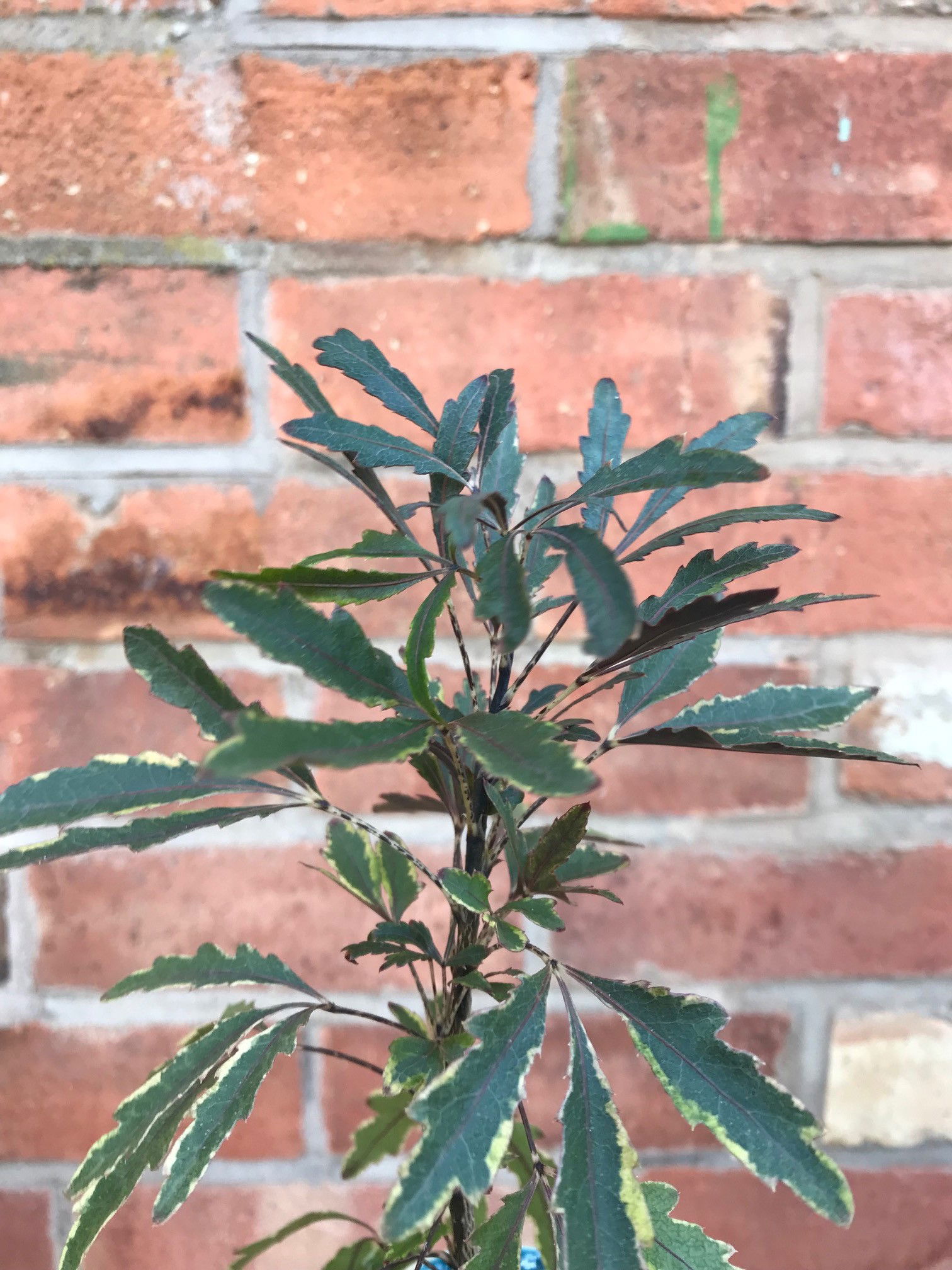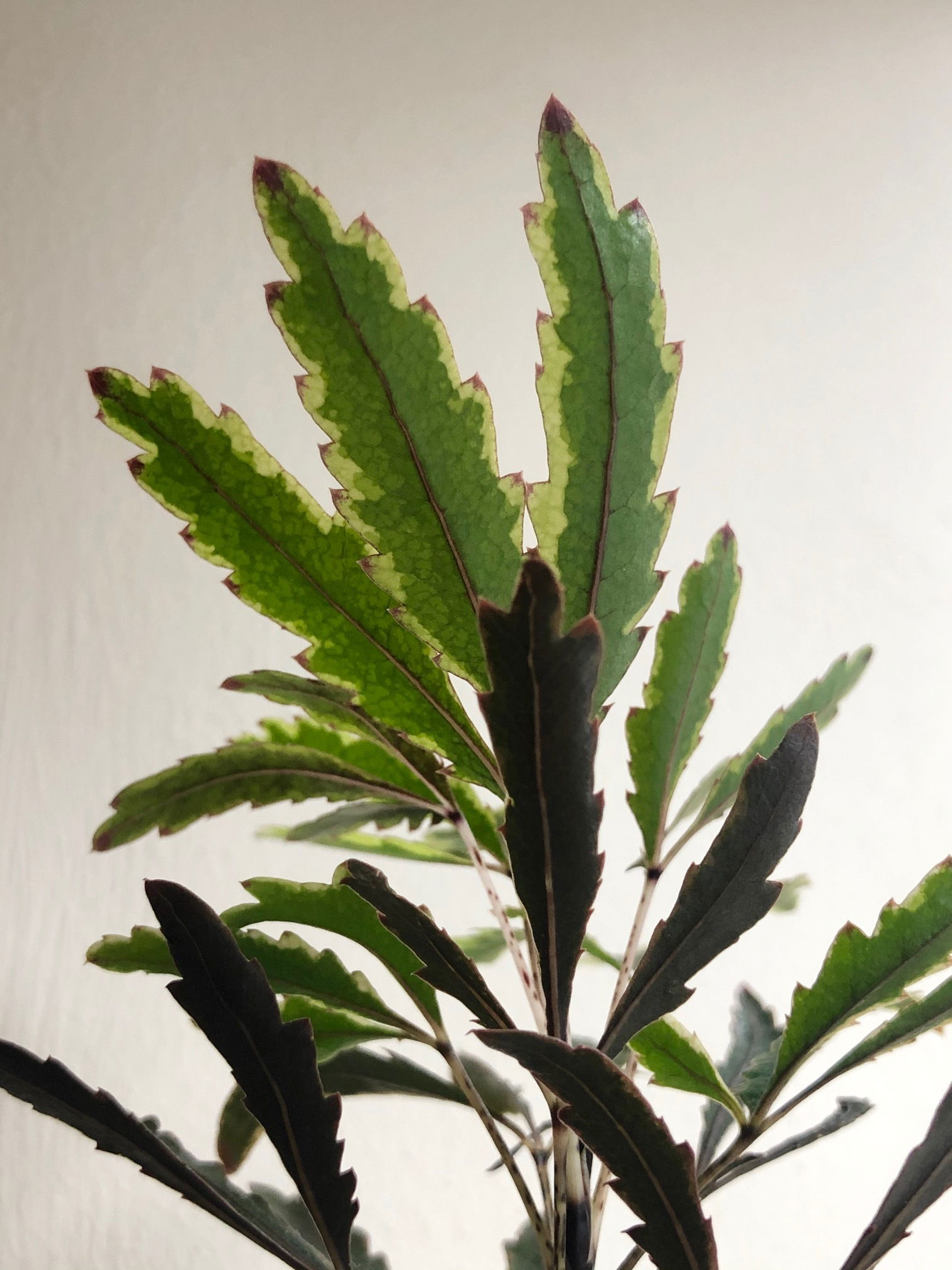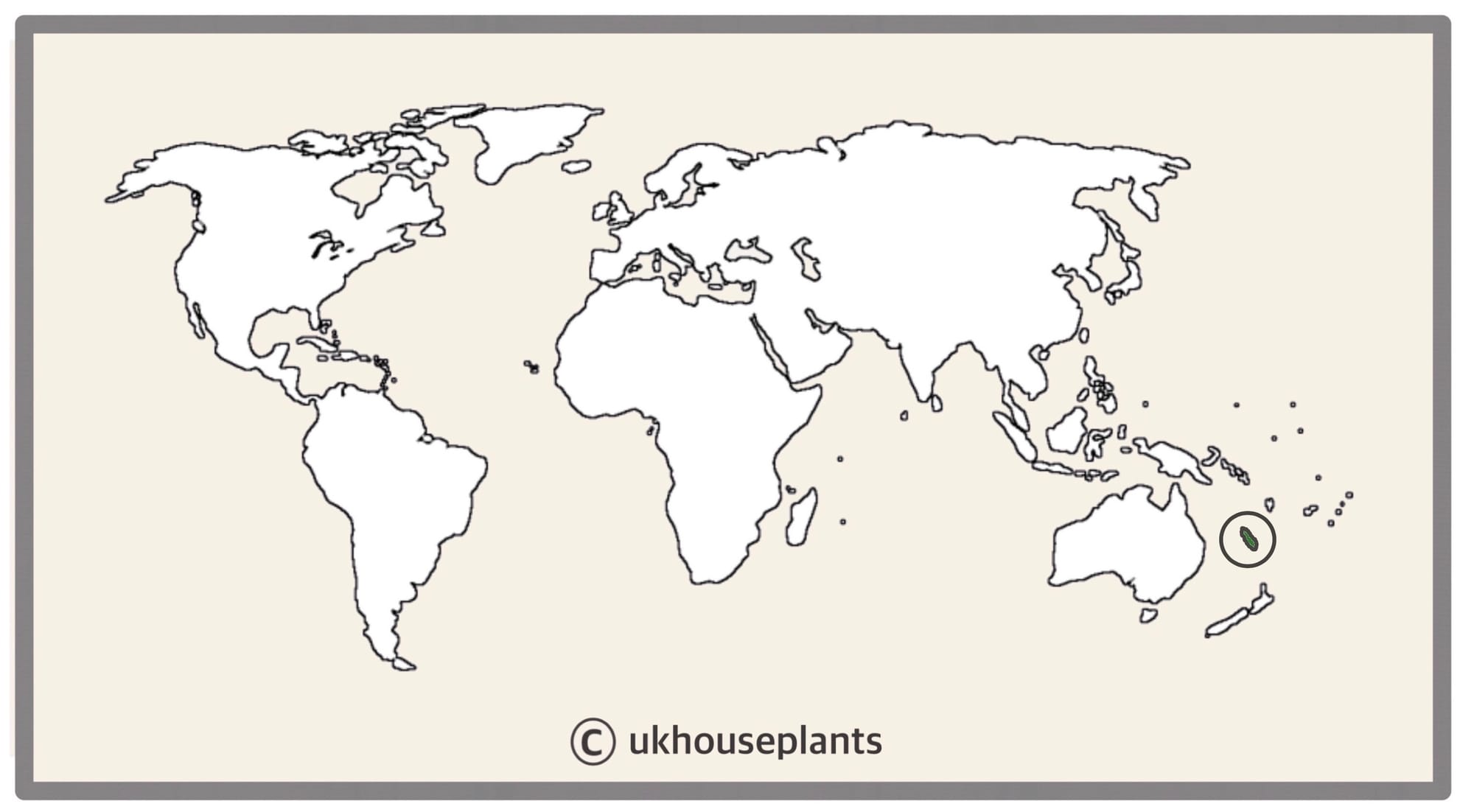
Plerandra elegantissima 'Variegata'
Contents
- Top Tips
- Location, Water, Humidity & Fertilisation
- Common Issues
- Origins, Temperature, Propagation, Repotting & Toxicity.
Need the answer to a specific plant query? Book a 1-to-1 video call with THE HOUSEPLANT DOCTOR™, the website's friendly author, to overcome and address your niggling problem! Available on iMessage, WhatsApp, Facebook Messenger & more.
Top Tips & Info
- Care Difficulty - Easy
- Provide a bright location away from direct sunlight.
- Water once the soil's top third dries out, reducing this further in the autumn and winter.
- Provide a humid location by introducing a pebble tray to keep the surrounding moisture constant throughout the year.
- Fertilise using a 'Houseplant' labelled feed every four waters in the spring and summer, reducing this to every six in the colder months.
- Regularly check for pests, most notably Mealybugs and Spider Mites that'll locate themselves in the cubbyholes of the foliage.
- Repot every three years using a 'Houseplant' potting mix and the next sized pot.
Location & Light - 🔸🔸
All levels of indirect light are tolerable, along with a possibility of morning winter sun. Avoid all-day exposure in the height of spring and summer as yellowed foliage is a clear sign of sun-scorch. Over-watering can result in root rot, commonly associated with those grown in darker locations.
Water - 🔸🔸
Persistent droughts will quickly anger a False Aralia, with its lower leaves turning yellow. During the spring and summer, allow the soil's top third to dry out, reducing this further in its dormancy period. Under-watering symptoms include yellowing lower leaves, stunted growth and wilting. These issues are commonly due to either too much sunlight or heat, much-needed transplantation into a bigger pot or simply forgetfulness. Over-watering symptoms include yellowing lower leaves, mouldy soil, severe wilting and stem collapse. Prolonged sogginess will cause the plant to breakdown from the bottom up, thus inhibiting nutrient and water intake via the roots. For mild or severe cases of root rot, be sure to click on this link.
Humidity - 🔸🔸🔸
Create a humidity tray to provide a moist and stable environment for your plant. If the surrounding saturation is too low or the heat too high, its foliage may start to brown over and curl, especially in direct sunlight. Hose the foliage down from time to time to hydrate the leaves and keep the dust levels down.
Fertilisation - 🔸🔸
Fertilise every four waters during the growing period before reducing this to every six in the autumn & winter. Although an 'All-Purpose' fertiliser will still do the job, we'd recommend using a specific 'Houseplant' labelled fertiliser as it'll support the vital thirteen nutrients that this species will need to grow.
 Due to its similar palmate structures, this species was originally classified under the Schefflera genus in 1878.
Due to its similar palmate structures, this species was originally classified under the Schefflera genus in 1878.
Common Issues with False Aralia
If you still can't find the answer to your specific houseplant problem, book a 1-to-1 video call with THE HOUSEPLANT DOCTOR™ to point you in the right direction today.
Brown crispy new-growth that's become deformed is the product of over-exposure to the sun and dehydration. As mentioned previously, False Aralia will grow best in bright, indirect light with regular waters. Remove the affected leaves and improve the growing conditions to counteract this issue occurring again. In some cases, Spider Mites could be the culprit for the abnormality, with small, near-transparent critters slowly extracting the chlorophyll out of the leaves. Have a check under the rest of the foliage, most notably along the midrib, for small webs and gritty yellow bumps. Click here to read our article about the eradicating Spider Mites, along with some extra tips that you may not find elsewhere!
Root rot is a common issue among specimens sat in too dark environments with prolonged soil moisture. Symptoms include rapidly yellowing leaves, mouldy soil, stunted growth and a rotten brown base. Take the plant out of the pot and inspect health below the soil line. If the roots sport a yellow tinge, you're good to go, but if they're brown and mushy, action must be taken immediately. More information about addressing root rot can be found on this link.
Fluctuations of humidity or temperatures may cause the dropping of older leaves, especially if it dips below 15°C (59°C). False Aralia must be grown in a stable environment throughout the year, so for those situated in dry climates (below 40%), introduce a humidity tray to balance out the surrounding air moisture.
Origins
The genus, Plerandra, originates from New Caledonia, just off the east coast of Australia and form of the Araliaceæ family. This species has jumped between the genera of Aralia in 1872, Schefflera in 1878 (Umbrella Trees), & Dizygotheca thirty years later - before its final resting place in Plerandra in 2013. This species has been since been placed in the 'Endangered' category by the IUCN.
 The Distribution of Plerandra elegantissima.
The Distribution of Plerandra elegantissima.
Temperature
13° - 24°C (56°- 75°F)
H1b (Hardiness Zone 12) - Can be grown outdoors during the summer in a sheltered location with temperatures above 12℃ (54℉), but is fine to remain indoors, too. If you decide to bring this plant outdoors, don't allow it to endure any direct sunlight as it may result in sun-scorch and dehydration. Regularly keep an eye out for pests, especially when re-introducing it back indoors.
Spread
Up to 2.2m in height and 1.5m in width. The ultimate height will take between 5 - 10 years to achieve, with 10cm of growth per season.
Pruning & Maintenance
Remove yellow or dying leaves, and plant debris to encourage better-growing conditions. While pruning, always use clean scissors or shears to reduce the chance of bacterial and fungal diseases. Never cut through yellowed tissue as this may cause further damage in the likes of diseases or bacterial infections. Remember to make clean incisions as too-damaged wounds may shock the plant, causing weakened growth and a decline in health.
Propagation
Via Seed or Stem Cuttings.
Stem & Eye Cuttings (Moderate) - This method of propagation is troublesome without the aid of bottom-heat and a controlled environment. Choose the healthiest, most established stems that are wooded, yet still juvenile enough to bend slightly, being just thicker than a pencil. Each cutting should only have ONE leaf, and a small portion of the stem to either side of the node. Cut directly below a node using a clean knife to reduce bacteria count. Situate the cutting into moist 'Houseplant' compost, with the only the leaf sticking out of the soil. Blackleg can occur when the bottom wound becomes infected, resulting in propagation failure - typically caused by water-logging or a too-damaged wound. Maintain bright light and evenly moist soil with the avoidance of direct sunlight or cold draughts. Wrap the pot (& foliage) in a transparent bag or within a miniature greenhouse, and provide bottom heat of temperatures above 18°C (54°F). Remove the bag and place into individual 7cm (3 inches) pots once the second new leaf emerges. Follow the same care routines, as mentioned in the article's top half. This method will take up to five months, so patience and the correct environment are paramount for success!
Flowers
False Aralia will produce small green flowers in the summer months that'll develop into black berries if successfully pollinated.
Repotting
Repot every two years in the spring using a 'Houseplant' labelled compost and the next sized pot with adequate drainage. Hydrate the plant 24hrs before tinkering with the roots to prevent the risk of transplant shock. For those that are situated in a darker location, add a thin layer of small grit in the pot's base to improve drainage and downplay over-watering. Click here for a detailed step-by-step guide on transplantation, or via this link to learn about repotting with root rot.
Book a 1-to-1 video call with THE HOUSEPLANT DOCTOR™ if you'd like a personal guide to repotting your houseplant. This will include recommending the right branded-compost and pot size, followed by a live video call whilst you transplant the specimen for step-by-step guidance and answer any further questions!
Pests & Diseases
Keep an eye out for mealybugs, spider mites, scale, thrips & whitefly that'll locate themselves in the cubbyholes and undersides of the leaves. Common diseases are root rot, leaf-spot disease, botrytis, powdery mildew & southern blight - click here to learn more about these issues.
Toxicity
This plant is classified as poisonous. If parts of the plants are eaten, vomiting, nausea and a loss of appetite could occur. Consumption of large quantities must be dealt with quickly - acquire medical assistance for further information.
Retail Locations
Online Stores.
Book a 1-to-1 Call with THE HOUSEPLANT DOCTOR™
If you need further advice with your houseplants, book an advice call with ukhouseplants' friendly and expert writer today! This can be done via a video or audio call on most apps, including Facebook, FaceTime & Skype. A ten-minute call costs £5.99 (US$7), or £15.99 for thirty minutes. You can ask multiple questions, including queries on plants, pests, terrariums, repotting advice and anything in between. Please consider supporting this service to keep ukhouseplants thriving!